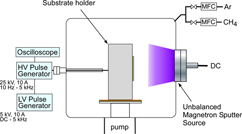Crossref Citations
This article has been cited by the following publications. This list is generated based on data provided by
Crossref.
Hatada, R.
Baba, K.
Flege, S.
Nakao, S.
and
Ensinger, W.
2012.
Preparation of Diamond-like Carbon Films by Plasma Source Ion Implantation with External Glow Discharge.
Transactions of the Materials Research Society of Japan,
Vol. 37,
Issue. 2,
p.
227.
Popa, A. C.
Stan, G. E.
Husanu, M. A.
Pasuk, I.
Popescu, I. D.
Popescu, A. C.
and
Mihailescu, I. N.
2013.
Multi-layer haemocompatible diamond-like carbon coatings obtained by combined radio frequency plasma enhanced chemical vapor deposition and magnetron sputtering.
Journal of Materials Science: Materials in Medicine,
Vol. 24,
Issue. 12,
p.
2695.
Flege, S.
Hatada, R.
Ensinger, W.
and
Baba, K.
2014.
Improved adhesion of DLC films on copper substrates by preimplantation.
Surface and Coatings Technology,
Vol. 256,
Issue. ,
p.
37.
Hatada, R.
Flege, S.
Bobrich, A.
Ensinger, W.
and
Baba, K.
2014.
Surface modification and corrosion properties of implanted and DLC coated stainless steel by plasma based ion implantation and deposition.
Surface and Coatings Technology,
Vol. 256,
Issue. ,
p.
23.
Das, Debajyoti
and
Banerjee, Amit
2015.
Anti-reflection coatings for silicon solar cells from hydrogenated diamond like carbon.
Applied Surface Science,
Vol. 345,
Issue. ,
p.
204.
Zahid, Rehan
Masjuki, Haji Hassan
Varman, Mahendra
Kalam, Muhammad Abul
Mufti, Riaz Ahmad
Mohd Zulkifli, Nurin Wahidah Binti
Gulzar, Mubashir
and
Nor Azman, Siti Safiyah Binti
2016.
Influence of intrinsic and extrinsic conditions on the tribological characteristics of diamond-like carbon coatings: A review.
Journal of Materials Research,
Vol. 31,
Issue. 13,
p.
1814.
Chang, Ya Chen
Liao, Wei Bo
Wei, Hung Sen
Liao, Yan Yu
Chen, Hung Pin
and
Kuo, Chien Cheng
2018.
Fabrication of Transparent Very Thin SiOx Doped Diamond-Like Carbon Films on a Glass Substrate.
Coatings,
Vol. 8,
Issue. 7,
p.
240.
Hatada, Ruriko
Flege, Stefan
Ashraf, Muhammad Naeem
Timmermann, Arne
Schmid, Christoph
and
Ensinger, Wolfgang
2020.
The Influence of Preparation Conditions on the Structural Properties and Hardness of Diamond-Like Carbon Films, Prepared by Plasma Source Ion Implantation.
Coatings,
Vol. 10,
Issue. 4,
p.
360.
Zhang, Tengfei
Xu, Zhaoying
Wang, Jinbiao
Huang, Weijiu
Hou, Xiaodong
Paddea, Sanjooram
and
Su, Yongyao
2021.
Failure Behavior of Hydrogenated and Hydrogen Free Diamond Like Carbon (DLC) Films in Water Environment.
Journal of Bio- and Tribo-Corrosion,
Vol. 7,
Issue. 4,
Alamgir, Asad
Bogatov, Andrei
Jõgiaas, Taivo
Viljus, Mart
Raadik, Taavi
Kübarsepp, Jakob
Sergejev, Fjodor
Lümkemann, Andreas
Kluson, Jan
and
Podgursky, Vitali
2022.
High-Temperature Oxidation Resistance and Tribological Properties of Al2O3/ta-C Coating.
Coatings,
Vol. 12,
Issue. 4,
p.
547.
Saha, Sucharita
and
Das, Debajyoti
2022.
Growth of diamond-like carbon films with significant nanocrystalline phases in a low-pressure high-density CH4 plasma in ICP-CVD: Effect of negative dc substrate bias.
Applied Surface Science,
Vol. 596,
Issue. ,
p.
153638.
